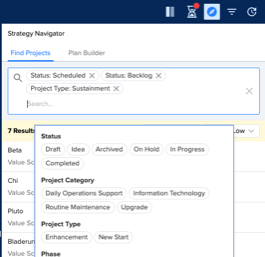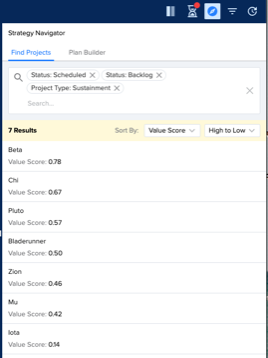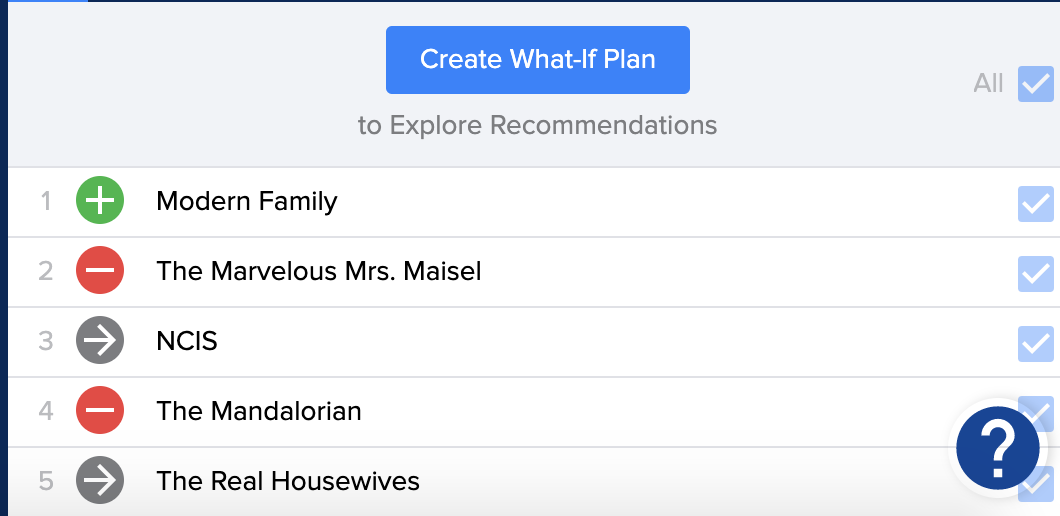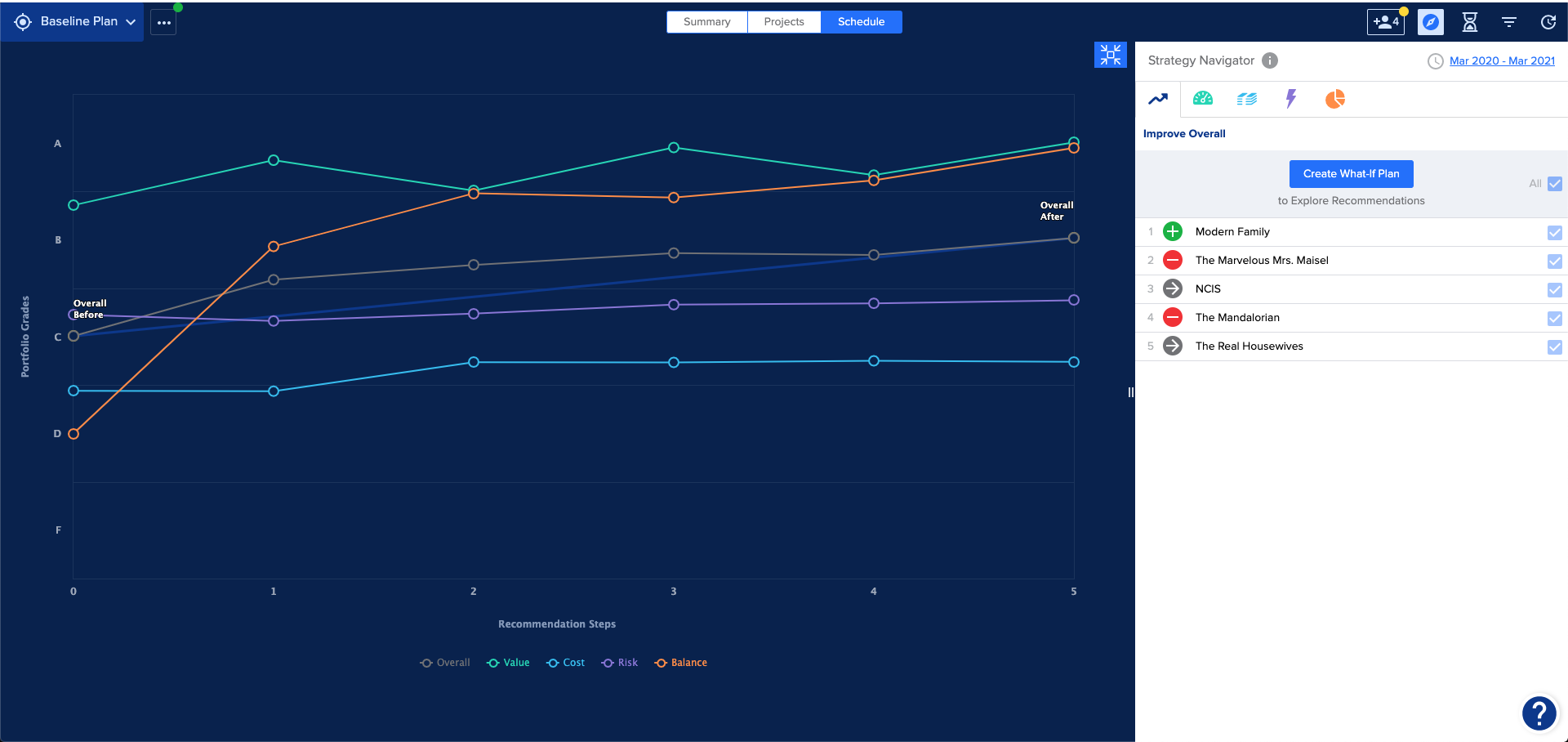Strategy Navigator can help you find the right projects for a plan, factoring in the areas you are trying to improve upon within your portfolio when scenario planning.
Open Strategy Navigator from the Budgets or Schedule page. Strategy Navigator is broken into two ways to help find projects for a plan.
Find Projects
The Find Projects tab gives you a quick way to find projects based upon a status or category. You can add as many statuses or categories to the search as you want, and results will always be based off all projects in the portfolio – regardless of the time frame that is set for the page or the start or end date of the project.

Results will automatically be sorted by Value Score, or Total Request (when no fields have been mapped to Value). Adjust the sort order, to view projects in a meaningful way, based upon any numeric, cost, or rank field.

Select a project name to open its details and begin adjusting your plan. For example, move a project to a funded or unfunded status to add or remove it to your current plan or adjust a projects cost data to give it more or less funds depending on resourcing constraints.
Plan Builder
The Decision Lens Accelerate Plan Builder suggests which projects could be added, removed or shifted in or out of a plan in order to improve the overall grade or improve on a specific dimension.
To use the Plan Builder, navigate to the Budgets page and select the Strategy Navigator icon. Select the Plan Builder tab. If using Plan Builder in the Baseline Plan, you will be prompted to create at What-If plan and apply recommendations there.

Within Plan Builder, select one of the tabs to get a set of recommended projects that should be added or removed into your plan. By default, recommendations are given to improve across Value, Cost, Risk and Balance. To improve upon a particular dimension within the Decision Lens Framework, select either the Value, Cost, Risk or Balance tab in Plan Builder. Selecting one of these tabs will give you recommendations to improve on the dimension selected.
Recommendations are based off the time frame that is set in the pages date range in the upper right hand corner. Recommendations can only be made for future time periods and for time periods that have established budgets.
Recommendations List
Recommendations are listed by order of impact for the plan and each will have an icon to show if the project would be added, removed or shifted in or out of the timeframe that was set in the Recommendation Horizon. If exploring recommendations from the Baseline, you will be prompted to create a what-if plan where you can apply the recommendations.

| Icon | Meaning |
 |
Add the project to the plan |
 |
Remove the project from the plan |
 |
Move the project outside of the Recommendation Horizon |
 |
Move the project inside of the Recommendation Horizon |
Each project has a checkbox that can be de-selected if any of the recommendations should not be applied. Removing a project from the recommendation list will impact Recommendation Engines plan and could give a different result from that displayed on the graph.
Once recommendations have been applied to a plan, an option to compare the plan displays so that the what-if plan can be compared to the Baseline or any other plan.
Recommendation Rationale
The graph at the top of the recommendation panel illustrates how each recommendation does overall and across each dimension to easily understand what each recommendation would give the plan and how it helps achieve a better overall grade.
The x-axis represents each recommendation listed within the panel and the y-axis represents the grades.
The straight line on the graph represents the trend of the plans overall grade and highlights the overall grade of the plan before applying recommendations and the overall grade of the plan after applying all recommendations listed.
The graph can be expanded or collapsed, and each dimension can be added to the chart by selecting the dimension within the legend.
In order to achieve a better overall grade, or improve within a single dimension, all recommendations listed should be applied. If a recommendation is deselected, a message will display on the graph to inform that the current set of recommendations have been invalidated.

Recommendation Targets
The default set of recommendations will be for overall improvements to try and obtain a maximum overall Grade across Value, Cost, Risk and Balance. However, users have the ability to tailor recommendations to target specific improvement areas. The various targeted recommendations can be generated by clicking on the individual icons, changing the recommendations to specifically skew to improving Value, Cost, Risk or Balance as desired.
Project Locking
Projects can be locked in order to maintain their current Plan information. Only Plan owners can Lock projects. Projects can be locked by clicking on the more menu next to the Project name in the Project or Schedule pages and clicking Lock Project. Locking can also be accomplished via the Project Details view by clicking the lock icon.

Locking a project will lock down the editing of any Schedule planning data which includes Status, Start Date, End Date, and Allocation. In order to manually edit these data fields, a locked project would first have to be unlocked. Locking will also remove the associated project from any recommendations.
Applying Recommendations
Recommendations are listed by order of impact for the plan and each will have an icon to show if the project would be added, removed or shifted in or out of the timeframe that was set in the Recommendation Horizon. If exploring recommendations from the Baseline, you will be prompted to create a what-if plan where you can apply the recommendations.
| Icon | Meaning |
 |
Add the project to the plan |
 |
Remove the project from the plan |
| Move the project outside of the Recommendation Horizon | |
| Move the project inside of the Recommendation Horizon |
Each project has a checkbox that can be de-selected if any of the recommendations should not be applied. Removing a project from the recommendation list will impact Recommendation Engines plan and could give a different result from that displayed on the graph.
Once recommendations have been applied to a plan, an option to compare the plan displays so that the what-if plan can be compared to the Baseline or any other plan.
Please see the related video